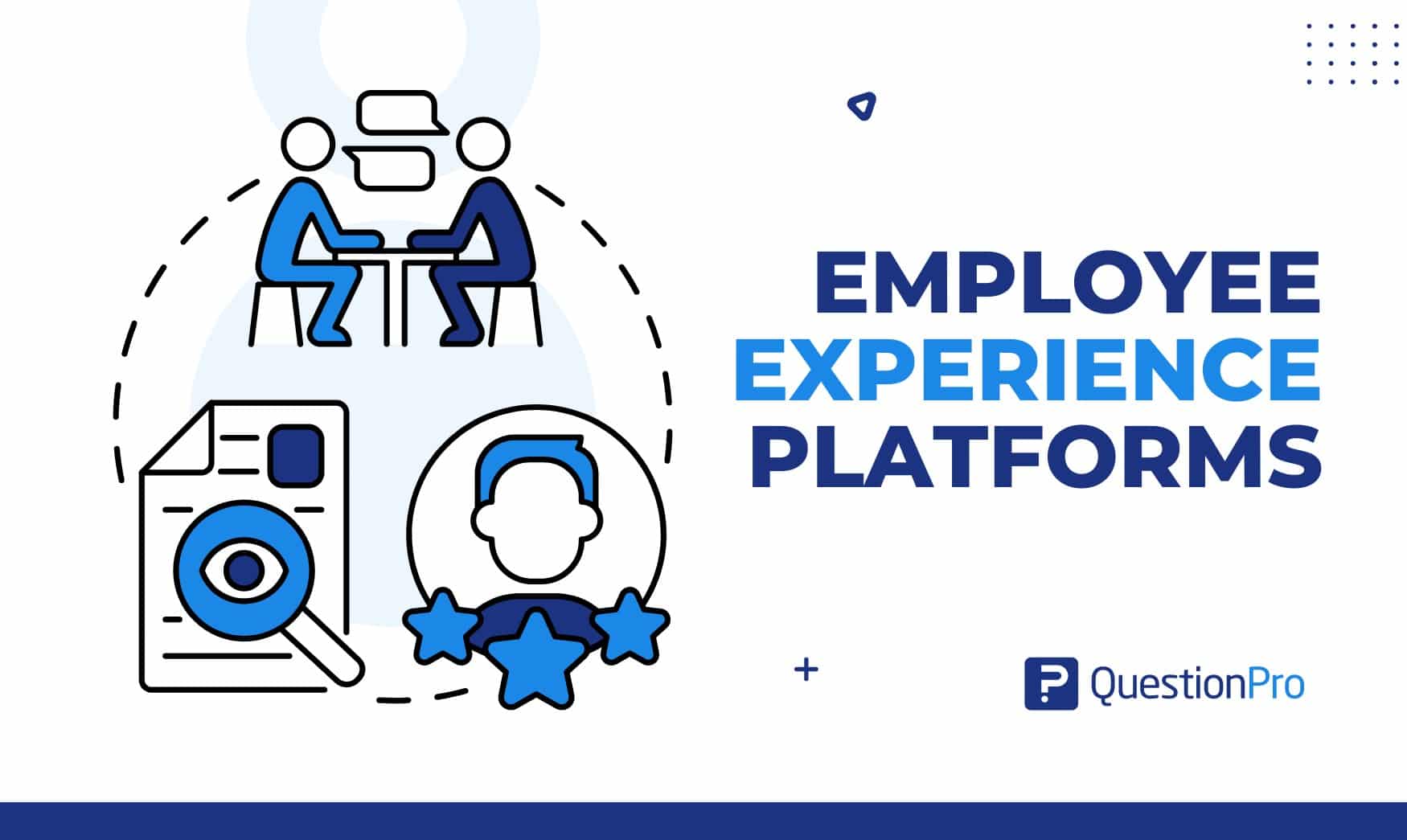
As companies recognize the importance of prioritizing employee satisfaction and well-being, the demand for employee experience platforms continues to surge. These platforms streamline various aspects of the employee journey, from recruitment and onboarding to performance management and feedback.
In 2025, several standout platforms have emerged as leaders in enhancing employee experience and fostering a positive workplace culture. Here are the 11 best employee experience platforms for 2025:
What are employee experience platforms?
Employee Experience Platforms (EXPs) are comprehensive digital solutions designed to enhance and optimize employees’ overall experience within an organization. They integrate various tools and technologies to streamline processes, improve communication, foster collaboration, and prioritize employee well-being.
These platforms focus on creating a positive work environment where employees feel valued, engaged, and motivated to contribute their best.
At their core, Employee Experience Platforms are built to address the evolving needs and expectations of modern workforce dynamics. They recognize that employees are more than just workers; they are individuals with unique talents, aspirations, and preferences.
Thus, EXPs aim to provide personalized experiences tailored to each employee, ultimately increasing job satisfaction, productivity, and retention rates.
Key Features of an Employee Experience Platform
Employee Experience Platforms (EXP) typically offer a range of features and functionalities, including but not limited to:
1. Employee Engagement Tools
These tools facilitate two-way communication between employees and management by
- Allowing feedback,
- Recognition and,
- Idea-sharing.
Features may include
- Employee surveys,
- Pulse checks,
- Social recognition and,
- Internal communication channels.
2. Learning and Development Resources
EXPs often include access to
- Online learning platforms,
- Training modules and
- Skill development courses.
These resources empower employees to continuously grow and acquire new skills, enhancing their professional development and career advancement opportunities.
3. Performance Management Systems
These systems enable
- Transparent performance evaluations,
- Goal-setting and
- Feedback mechanisms.
Managers can track
- Employee progress,
- Provide timely feedback,
- Identify areas for improvement,
- Fostering a culture of continuous feedback and improvement.
4. Well-being and Work-Life Balance Tools
EXPs prioritize employee well-being by offering resources and support for
- Physical,
- Mental and
- Emotional health.
This may include
- Wellness programs,
- Mindfulness exercises,
- Work-life balance initiatives and
- Access to employee assistance programs (EAPs).
5. Recognition and Rewards Platforms
Recognizing and rewarding employees’ contributions is essential for creating a positive work culture. EXPs often include
- Peer-to-peer recognition,
- Milestone celebrations and
- Incentive programs to acknowledge and incentivize high performance.
6. Employee Self-Service Portals
These portals empower employees to independently manage their HR-related tasks and access relevant information. This reduces the administrative burden on HR teams and gives employees greater autonomy over their work-related activities.
7. Analytics and Insights
EXPs leverage data analytics to provide actionable insights into
- Employee engagement,
- Satisfaction levels and
- Overall organizational performance.
These insights enable managers to make data-driven decisions and continuously improve the employee experience.
Why Choose the Best Employee Experience Platforms?
Investing in top employee experience platforms brings substantial benefits and offers a strategic advantage to organizations. Here’s why management should prioritize the best EEPs, illustrated with practical examples:
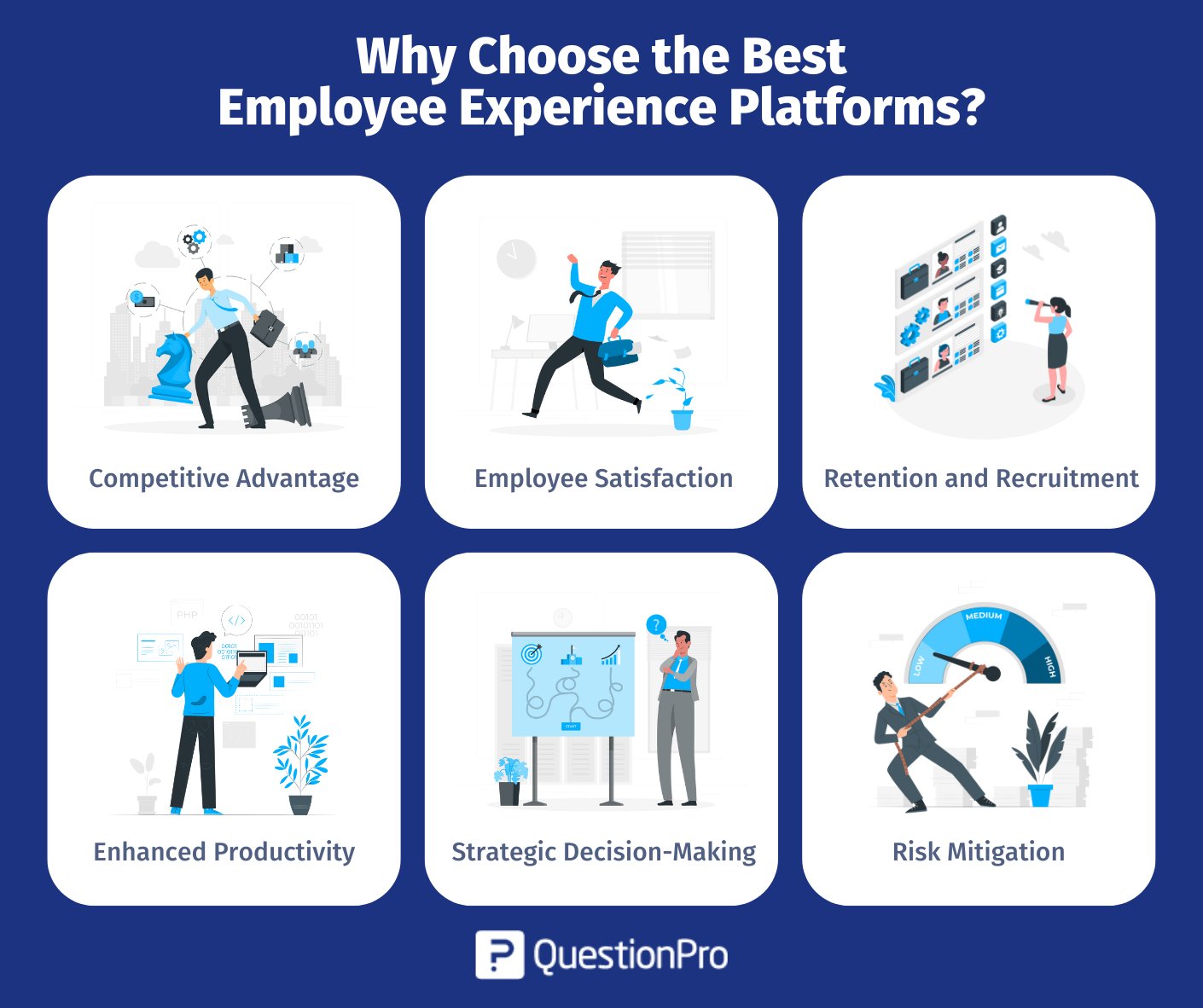
Competitive Advantage
Organizations prioritizing employee experience gain a competitive edge in attracting and retaining top talent. A positive workplace environment enhances the employer brand and distinguishes the organization as an employer of choice.
- Example: Company A implements a leading EEP that enhances employee engagement through personalized development plans and recognition programs. This fosters a positive workplace culture, setting Company A apart as an employer of choice.
- Impact: By prioritizing employee experience, organizations attract top talent who value a supportive work environment, giving them a competitive edge in talent acquisition and retention.
Employee Satisfaction
High levels of employee satisfaction lead to greater productivity, creativity, and loyalty. Investing in the best EEP demonstrates management’s commitment to fostering a positive work culture and valuing employee well-being.
- Example: Company B adopts a comprehensive EEP integrating feedback mechanisms and wellness programs. This investment demonstrates a commitment to employee well-being and fosters a culture where employees feel valued and motivated.
- Impact: Higher employee satisfaction correlates with increased productivity, creativity, and loyalty, driving organizational success.
Retention and Recruitment
The best EEPs help improve employee retention rates by creating a conducive work environment where employees feel valued and engaged. This reduces turnover costs and preserves institutional knowledge. Moreover, satisfied employees are more likely to refer their network to join the organization, easing recruitment efforts.
- Example: Company C implements an EEP emphasizing career development opportunities and transparent communication channels. Employees are more likely to stay in an organization that invests in their growth and well-being.
- Impact: Improved retention rates reduce turnover costs and preserve institutional knowledge. Satisfied employees become brand advocates, attracting talent through referrals and easing recruitment efforts.
Enhanced Productivity
EEPs optimize HR processes, streamline workflows, and provide employees with the tools and resources to perform their best. This results in increased productivity across the organization.
- Example: Company D leverages an EEP that streamlines HR processes, provides intuitive collaboration tools, and offers personalized learning paths. This empowers employees to work efficiently and innovatively.
- Impact: Optimized workflows and easy access to resources contribute to heightened productivity organization-wide, driving business outcomes.
Strategic Decision-Making
Leading EEPs offer advanced analytics and data-driven insights that enable management to make informed decisions regarding workforce strategies, talent management, and employee development initiatives. This ensures that resources are allocated effectively to achieve organizational goals.
- Example: Company E utilizes advanced analytics from its EEP to monitor engagement metrics, identify trends, and align talent strategies with business objectives. This data-driven approach ensures effective resource allocation and strategic workforce planning.
- Impact: Informed decisions based on real-time insights lead to more agile and responsive organizational strategies, enhancing overall performance and competitiveness.
Risk Mitigation
Top EEPs often come with robust security features and compliance measures, helping mitigate risks associated with data breaches or non-compliance with regulatory requirements. This protects both employees and the organization from potential legal and reputational risks.
- Example: Company F adopts a top-tier EEP equipped with robust security features and compliance measures. This safeguards sensitive employee data and ensures adherence to regulatory standards, minimizing legal and reputational risks.
- Impact: Mitigating risks associated with data breaches or non-compliance protects both employees and the organization, maintaining trust and operational continuity.
How to Choose The Right Employee Experience Platform
Choosing the right Employee Experience Platform (EEP) is crucial for any organization looking to enhance its workplace environment and streamline HR processes. Here’s a step-by-step guide on how to choose the right EEP:
1. Assess Your Needs and Objectives
Begin by understanding your organization’s specific needs and objectives regarding employee experience. Consider factors such as:
- Current pain points in HR processes
- Desired improvements in employee engagement and satisfaction
- Specific features or functionalities required to address these needs
2. Research Available Platforms
Conduct thorough research to identify EEPs that align with your organization’s requirements. Explore online reviews, industry reports, and recommendations from peers to compile a list of potential platforms.
3. Evaluate Key Features and Functionalities
Narrow down your list of EEPs and evaluate each platform’s key features and functionalities. Pay attention to aspects such as:
- Employee feedback mechanisms
- Performance management tools
- Learning and development modules
- Integration capabilities with existing systems
- Mobile accessibility and user interface
4. Consider Scalability and Flexibility
Choose an EEP that can scale with your organization’s growth and adapt to evolving needs. Ensure that the platform offers flexibility in terms of customization and configuration to accommodate your organization’s unique requirements.
5. Assess User Experience
User experience plays a crucial role in the successful adoption of an EEP. Look for a platform with an intuitive interface and user-friendly design to encourage employee engagement and participation.
6. Review Customer Support and Training
Evaluate the level of customer support and training provided by the EEP vendor. Ensure they offer comprehensive onboarding assistance, ongoing support, and resources to help your team make the most of the platform.
7. Check Integration Capabilities
Consider how well the EEP integrates with your existing HR systems and software. Seamless integration can streamline processes and enhance data consistency across platforms.
8. Evaluate Security and Compliance
Security and compliance are critical factors when choosing an EEP, especially if your organization deals with sensitive employee data. Ensure the platform complies with relevant data protection regulations and offers robust security features to safeguard confidential information.
9. Request Demos and Trials
Request demos or trials of shortlisted EEPs to experience their functionality firsthand. Take advantage of these opportunities to ask questions, test out features, and gauge the platform’s suitability for your organization’s needs.
10. Consider Cost and ROI
Finally, consider the cost of implementing and maintaining the EEP and its potential return on investment (ROI) in terms of improved employee engagement, productivity, and retention. Choose a platform that delivers value for money and aligns with your budgetary constraints.
Learn about our Company Culture Software
11 Best Employee Experience Platforms
Employee Experience Platforms (EXP) have become essential tools for organizations that enhance employee engagement, satisfaction, and productivity. These platforms typically offer features like employee feedback mechanisms, recognition tools, learning and development resources, and communication channels.
Here are 11 leading employee experience platforms:
1. QuestionPro Workforce
QuestionPro Workforce is an employee experience platform designed to help organizations improve engagement, productivity, and retention. It offers tools for conducting surveys, collecting feedback, and analyzing employee sentiment.
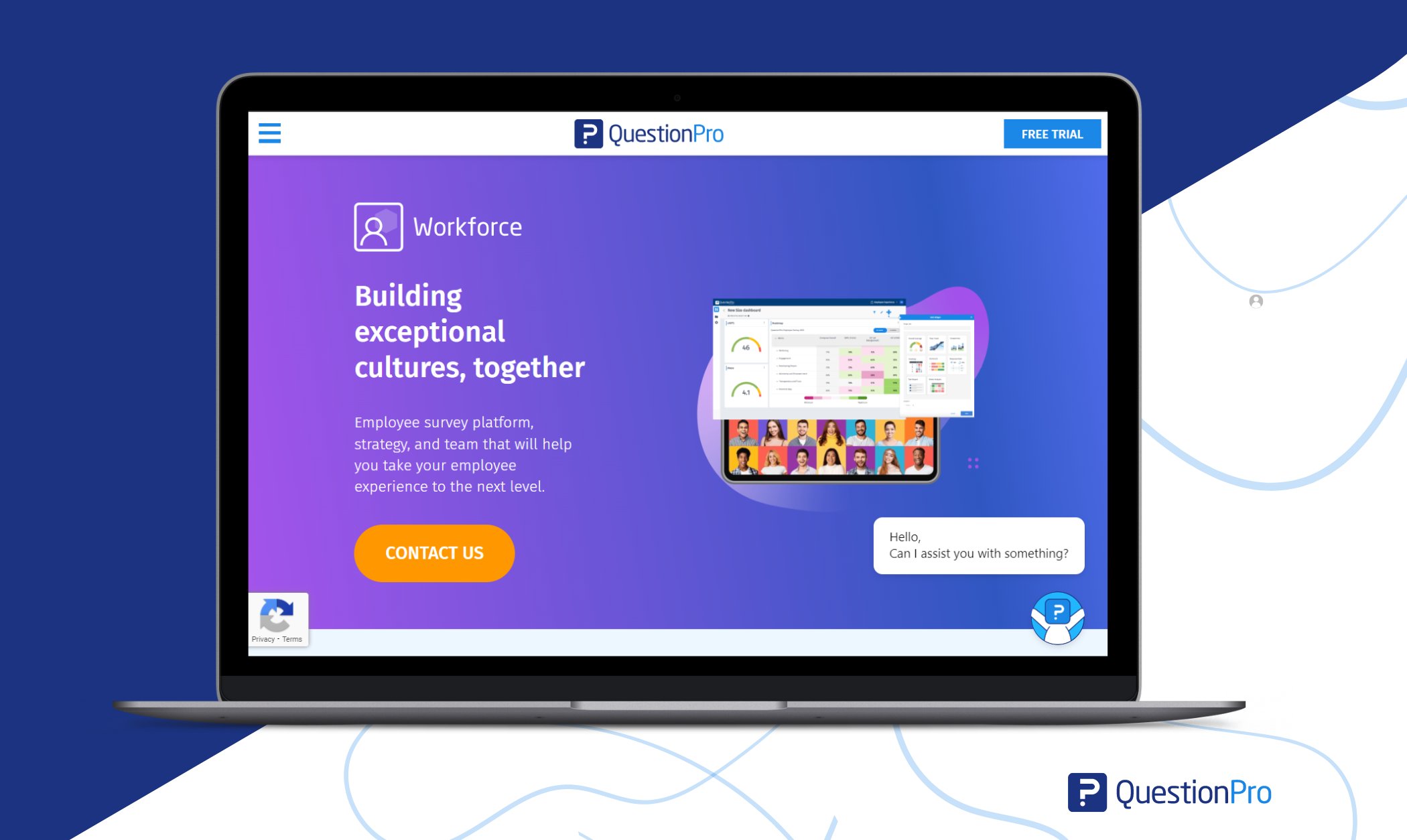
Features:
- Survey creation and deployment.
- Feedback collection through various channels.
- Real-time analytics and reporting.
- Action planning and tracking.
- Integration with HR systems.
Pros:
- User-friendly interface.
- Customizable surveys.
- Advanced analytics capabilities.
- Integration options for seamless workflow.
Cons:
- Pricing may be on the higher end for small businesses.
- Some users may require additional training for advanced features.
Price: Pricing varies based on the number of users and features required. Contact sales for a quote.
2. Culture Amp
Culture Amp is an employee feedback and analytics platform designed to help organizations understand and improve their culture. It offers features for measuring employee engagement, conducting surveys, and analyzing feedback.
Features:
- Pulse surveys.
- Performance reviews.
- 360-degree feedback.
- Culture analytics and insights.
- Action planning tools.
Pros:
- Comprehensive platform for understanding employee sentiment.
- Customizable surveys and feedback mechanisms.
- Advanced analytics for actionable insights.
- Integrations with HR systems.
Cons:
- Initial setup and implementation may require time and resources.
- Pricing may be prohibitive for small businesses.
Price: Pricing varies based on the number of employees and features required. Contact sales for a quote.
3. 15Five
15Five is a performance management platform focusing on continuous organizational feedback and alignment. It allows employees to share their progress, achievements, and concerns while managers can provide feedback and support.
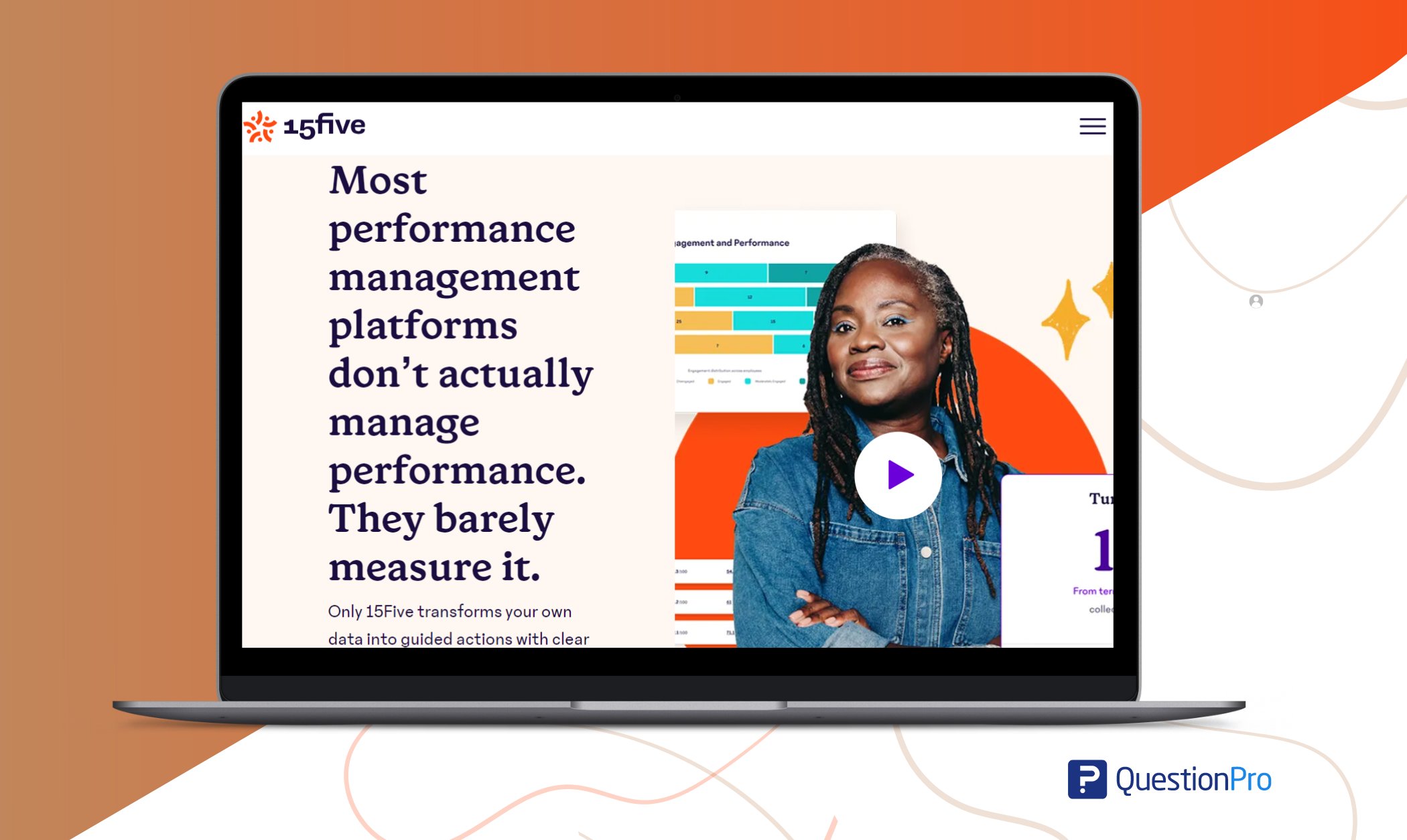
Features:
- Weekly check-ins and progress tracking.
- Goal setting and tracking.
- Peer recognition and feedback.
- Performance reviews.
- Analytics and reporting.
Pros:
- Simplified interface for easy adoption.
- Emphasis on continuous feedback and improvement.
- Goal alignment features.
- Integration with other HR tools.
Cons:
- Limited customization options for some features.
- May not suit organizations with complex performance management needs.
Price: Pricing varies based on the number of users and features required. Contact sales for a quote.
4. Lattice
Lattice is a comprehensive performance management platform that helps organizations develop their employees and build stronger teams. It offers goal setting, feedback, performance reviews, and career development tools.
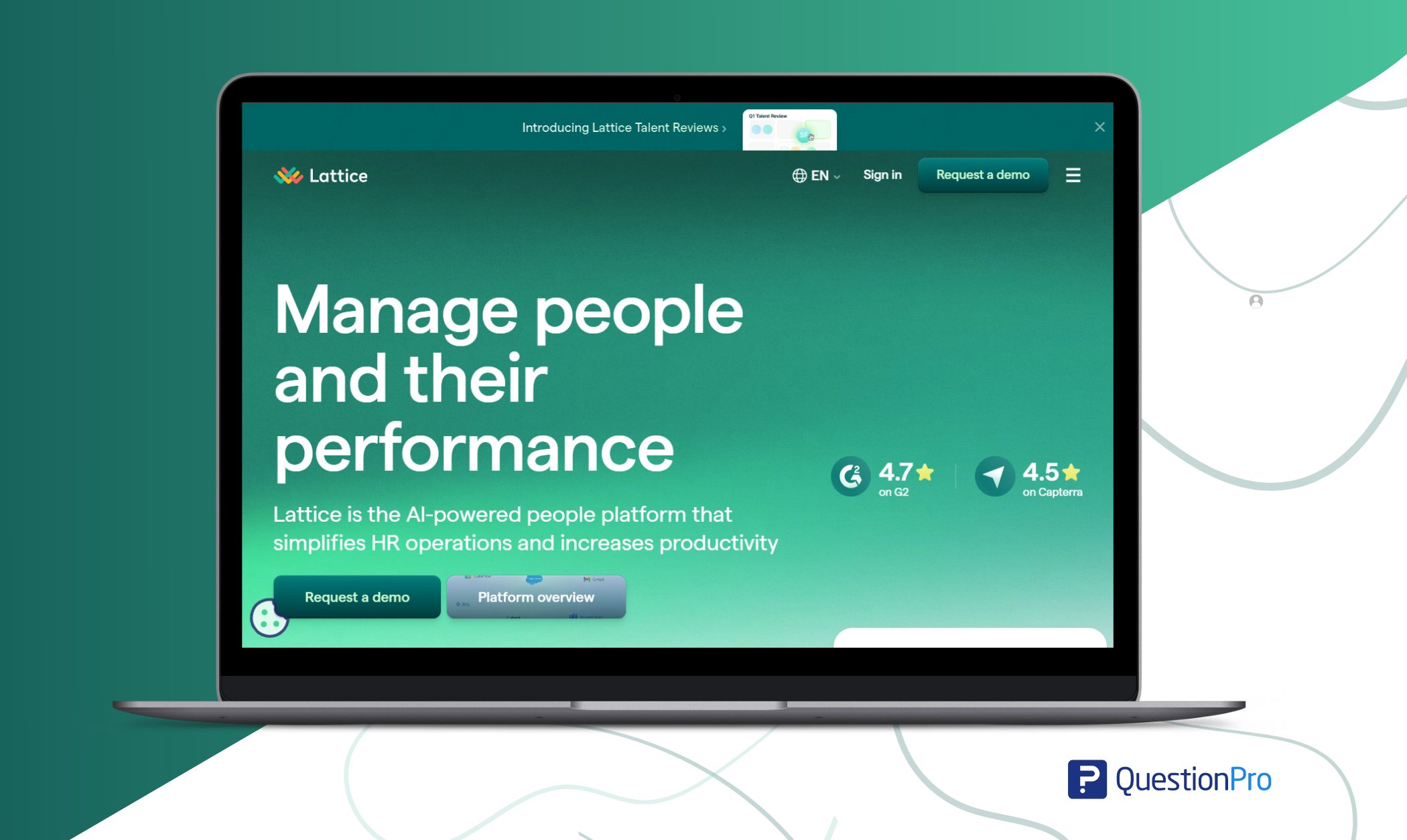
Features:
- Goal setting and tracking.
- Continuous feedback and recognition.
- Performance reviews and evaluations.
- Career development planning.
- Analytics and insights.
Pros:
- Intuitive interface with customizable features.
- Comprehensive performance management tools.
- Focus on employee development and growth.
- Integration with HRIS and other tools.
Cons:
- Pricing may be higher compared to some alternatives.
- Implementation may require initial effort for customization.
Price: Pricing varies based on the number of employees and features required. Contact sales for a quote.
5. Motivosity
Motivosity is an employee recognition and engagement platform that fosters a positive workplace culture. It enables peer-to-peer recognition, rewards, and feedback to promote team collaboration and appreciation.
Features:
- Peer-to-peer recognition.
- Rewards and incentives.
- Employee feedback tools.
- Social recognition feed.
- Analytics and insights.
Pros:
- Easy-to-use platform for fostering employee appreciation.
- Promotes a positive workplace culture.
- Encourages collaboration and teamwork.
- Integration options with HR systems.
Cons:
- May lack some advanced performance management features.
- Limited customization options for certain aspects.
Price: Pricing varies based on the number of users and features required. Contact sales for a quote.
6. Bonusly
Bonusly is an employee recognition and rewards platform that boosts organizational morale and engagement. It allows employees to give and receive micro-bonuses, which can be redeemed for rewards.
Features:
- Peer-to-peer recognition.
- Micro-bonuses and rewards.
- Integration with communication tools.
- Analytics and reporting.
- Customizable reward catalog.
Pros:
- Simple and intuitive platform for recognizing employees.
- Encourages frequent recognition and appreciation.
- Flexible reward options.
- Integration with popular communication tools like Slack.
Cons:
- May not offer comprehensive performance management features.
- Limited integration options with HR systems.
Price: Pricing varies based on the number of users and features required. Contact sales for a quote.
7. BambooHR
BambooHR is a human resources management system that includes features for employee experience management. It offers tools for onboarding, performance management, time tracking, and more.
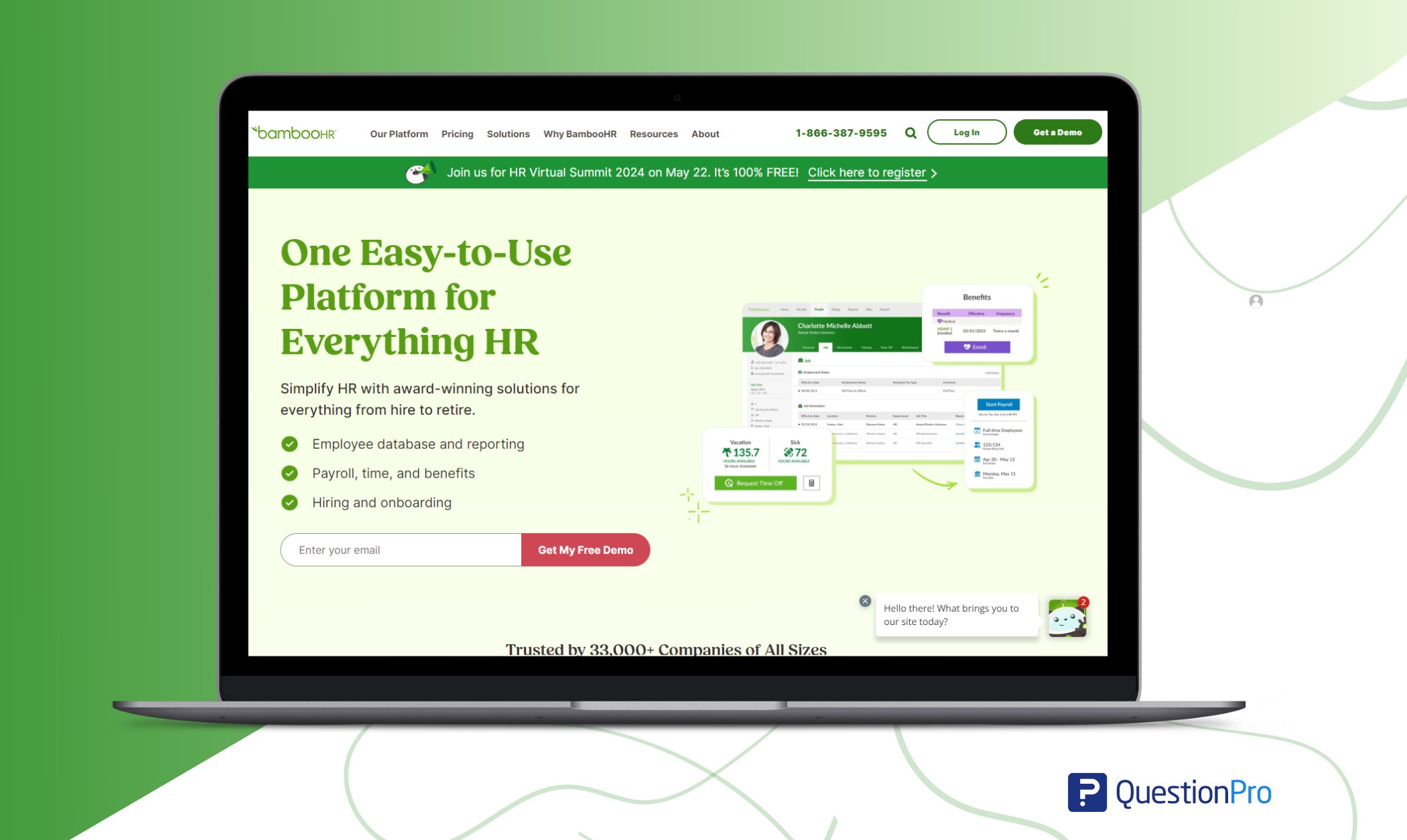
Features:
- Employee self-service portal.
- Onboarding and offboarding processes.
- Performance management tools.
- Time tracking and attendance management.
- Reporting and analytics.
Pros:
- Comprehensive HR management solution.
- User-friendly interface.
- Customizable workflows.
- Integration options with other HR and productivity tools.
Cons:
- May lack some advanced employee experience features compared to specialized platforms.
- Pricing may be higher for smaller organizations.
Price: Pricing varies based on the number of employees and features required. Contact sales for a quote.
8. Workvivo
Workvivo is an employee communication and engagement platform designed to connect and engage employees within organizations. It offers features for social networking, recognition, and building company culture.
Features:
- Social feed for employee communication.
- Employee recognition and rewards.
- Company news and announcements.
- Surveys and feedback tools.
- Integration with other workplace tools.
Pros:
- Promotes employee engagement and collaboration.
- User-friendly interface similar to social media platforms.
- Customizable features to reflect company culture.
- Integration options with existing workplace tools.
Cons:
- May not offer as many HR management features as some alternatives.
- Pricing may be higher for organizations with a large number of users.
Price: Pricing varies based on the number of users and features required. Contact sales for a quote.
9. Qualtrics EmployeeXM
Qualtrics EmployeeXM is an employee experience management platform that helps organizations measure and improve employee engagement, satisfaction, and productivity. It offers tools for collecting feedback, analyzing data, and taking action to enhance the employee experience.
Features:
- Employee feedback surveys.
- Pulse surveys for real-time insights.
- Text analytics for sentiment analysis.
- Action planning and follow-up tools.
- Integration with HR systems.
Pros:
- Powerful analytics capabilities for deep insights.
- Customizable surveys and feedback mechanisms.
- Actionable recommendations based on data analysis.
- Integration options with HR and other business systems.
Cons:
- Learning curve for advanced features may be steep for some users.
- Pricing may be higher compared to some alternatives.
Price: Pricing varies based on the number of employees and features required. Contact sales for a quote.
10. Officevibe
Officevibe is an employee engagement platform providing actionable employee insights to improve workplace culture and morale. It offers employee engagement softwares for measuring employee sentiment, conducting surveys, and tracking engagement metrics.
Features:
- Employee feedback surveys.
- Pulse surveys for regular check-ins.
- Team mood tracking.
- Performance analytics and benchmarks.
- Actionable recommendations and resources.
Pros:
- Simple and intuitive platform for measuring employee engagement.
- Regular pulse surveys for real-time insights.
- Actionable recommendations for improving workplace culture.
- Integration options with popular communication tools.
Cons:
- May lack some advanced features compared to more comprehensive platforms.
- Customization options may be limited for certain features.
Price: Pricing varies based on the number of users and features required. Contact sales for a quote.
11. TINYpulse
TINYpulse is an employee feedback platform that helps organizations gather insights, measure employee sentiment, and foster a positive work environment. It offers features for conducting surveys, recognizing employees, and tracking progress over time.
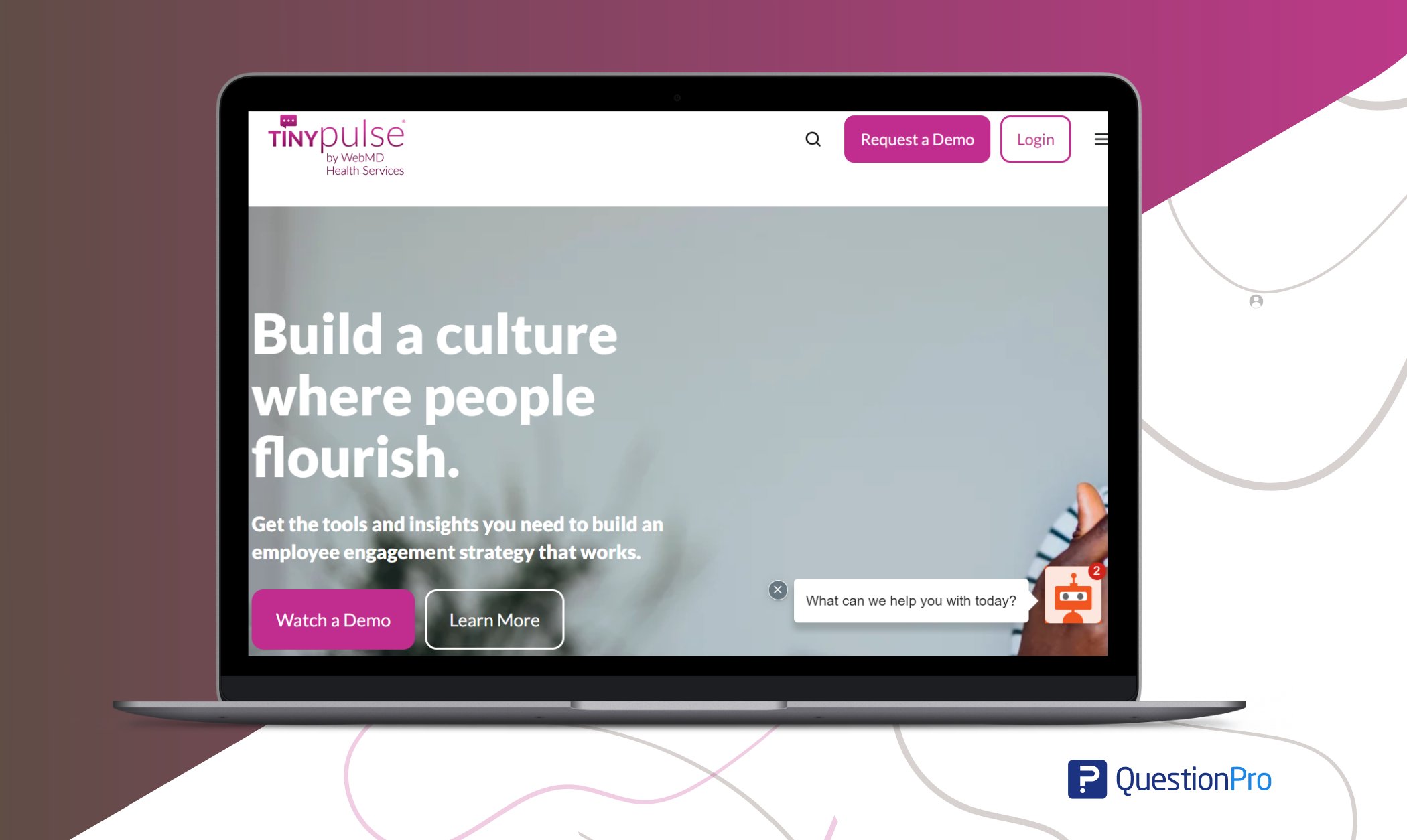
Features:
- Anonymous employee feedback surveys.
- Pulse surveys for regular check-ins.
- Employee recognition and appreciation tools.
- Performance analytics and trend tracking
- Integration with HR systems.
Pros:
- Emphasis on anonymous feedback for honest insights.
- Regular pulse surveys for ongoing engagement measurement.
- Employee recognition features to boost morale.
- Integration options with HR systems for streamlined processes.
Cons:
- May lack some advanced employee performance management features.
- Limited customization options for certain aspects.
Price: Pricing varies based on the number of users and features required. Contact sales for a quote.
Are you curious about Digital Experience Platforms? QuestionPro has recently published a blog that breaks down how they can revolutionize your customer journey!
Benefits of Using an Employee Experience Platform
Integrating an employee experience solution with engagement platforms and using employee experience management software creates a more cohesive workplace. Here are some key benefits:
- Enhanced Engagement: EXPs boost engagement by offering personalized experiences, including recognition programs, social connections, and customized learning pathways.
- Improved Productivity: They streamline processes, giving employees easy access to tools and resources, like task management, collaboration tools, and automated workflows.
- Better Communication: EXPs include chat, forums, and social feeds that promote open communication and collaboration, reducing silos and fostering community.
- Increased Retention: A positive employee experience is linked to higher retention rates; EXPs help create a supportive and inclusive work environment, reducing turnover.
- Personalized Development: They provide tailored learning and development opportunities based on employees’ skills, interests, and career goals.
- Data-Driven Insights: EXPs collect data on engagement and performance, offering insights to guide decision-making and drive continuous improvement.
- Enhanced Employer Brand: Investing in employee experience strengthens employer branding, attracting top talent and differentiating the organization in a competitive job market.
- Adaptability and Agility: EXPs are flexible and adaptable, supporting quick responses to changing needs, whether for remote work, onboarding, or new initiatives.
How QuestionPro Workforce Helps in Improving Employee Experience
QuestionPro Workforce is a comprehensive Employee Experience Platform (EEP) offering a range of features to enhance employee satisfaction and engagement. Here’s how QuestionPro Workforce helps in improving employee experience:
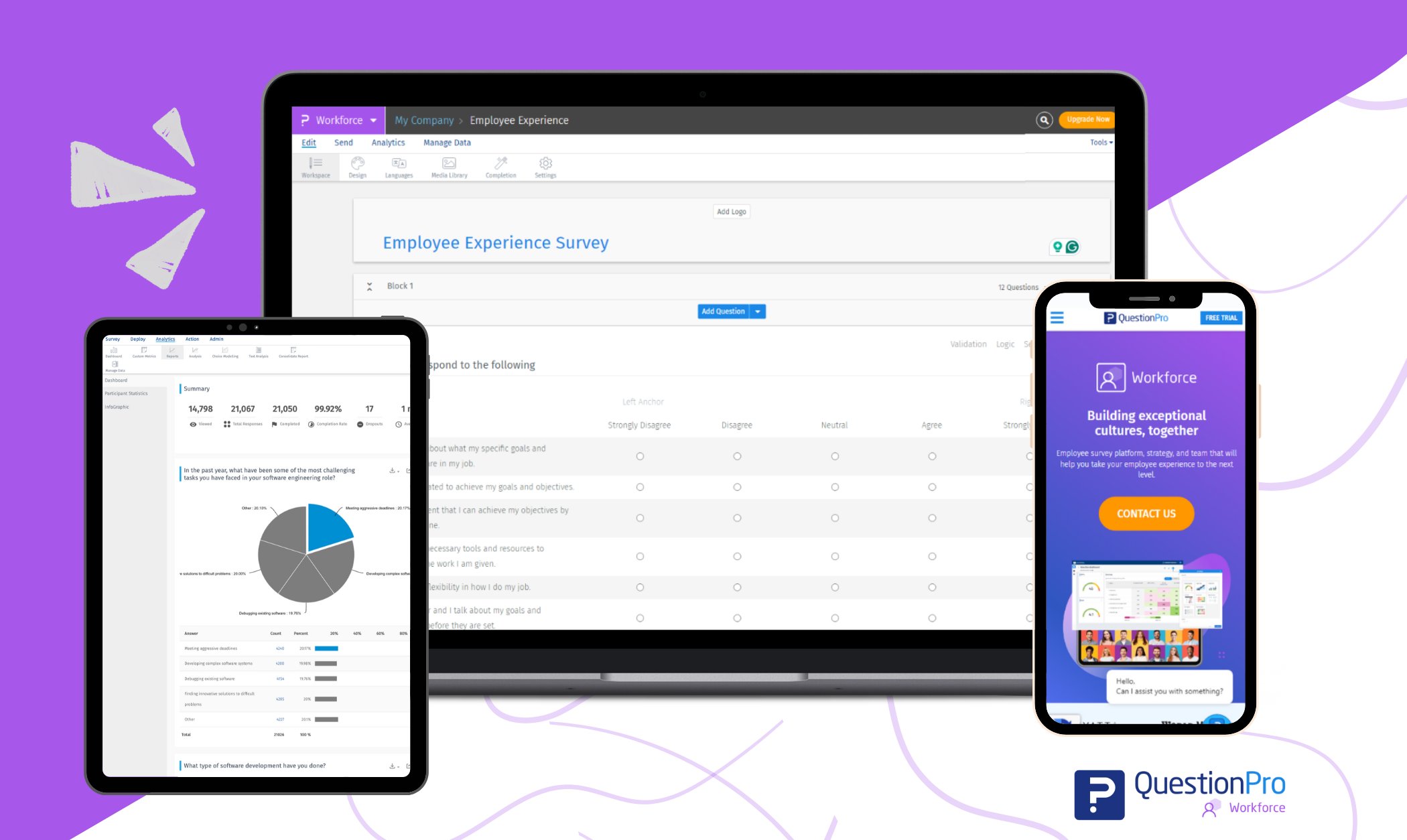
- 360-Degree Feedback: QuestionPro Workforce facilitates 360-degree feedback, allowing employees to receive comprehensive feedback from peers, managers, and subordinates. This fosters a culture of continuous improvement and professional development.
- Pulse Surveys: The platform enables organizations to conduct regular pulse surveys to gauge employee sentiment and gather feedback on various aspects of the workplace environment. This real-time feedback mechanism helps identify areas for improvement and address issues proactively.
- Performance Management: QuestionPro Workforce streamlines performance management processes by providing tools for setting goals, tracking progress, and conducting performance reviews. The platform helps employees understand their role in contributing to the company’s success by aligning individual goals with organizational objectives.
- Employee Recognition: The platform includes features for recognizing and rewarding employee achievements and milestones. Whether a simple thank-you message or a formal recognition program, QuestionPro Workforce helps organizations celebrate employee contributions and reinforce positive behaviors.
- Learning and Development: QuestionPro Workforce offers personalized learning and development modules that enable employees to access training materials tailored to their career goals and skill development needs. This empowers employees to take ownership of their professional growth and advancement within the organization.
- Analytics and Insights: The platform provides valuable data analytics and insights that help organizations understand employee engagement levels, identify trends, and track progress over time. These insights enable informed decision-making and drive continuous improvement in employee experience initiatives.
Conclusion
Employee Experience Platforms are integral tools for organizations looking to elevate their workplace culture and drive success. By prioritizing employee satisfaction, engagement, and well-being, EXPs empower organizations to unlock the full potential of their workforce.
Invest in the right EXP, like QuestionPro Workforce, and embark on a journey towards a more productive, cohesive, and thriving workplace environment.
QuestionPro Workforce is a powerful tool for organizations seeking to improve employee experience by fostering open communication, recognizing achievements, supporting professional development, and leveraging data-driven insights to create a positive and engaging workplace environment.
Frequently Asked Questions (FAQs)
A: An Employee Experience Platform (EXP) is a digital solution designed to enhance various aspects of an employee’s journey within an organization, from recruitment to career development.
A: Employee Experience Platforms are crucial in 2025 because they help organizations improve employee engagement, satisfaction, and retention, which are key to maintaining a competitive edge in a rapidly evolving job market.
A: Look for features such as employee feedback tools, performance management systems, learning and development resources, and well-being support to ensure a comprehensive approach to enhancing employee experience.
A: Employee Experience Platforms boost productivity by streamlining HR processes, enhancing communication, and providing tools that enable employees to perform their tasks more efficiently.
A: Yes, small businesses can benefit significantly from Employee Experience Platforms, which help create a positive work environment, streamline operations, and improve employee retention and satisfaction.







